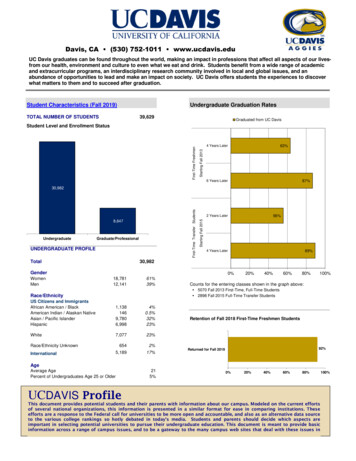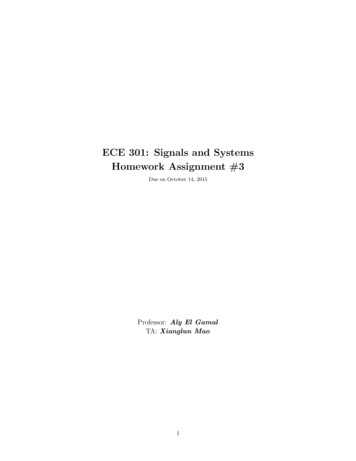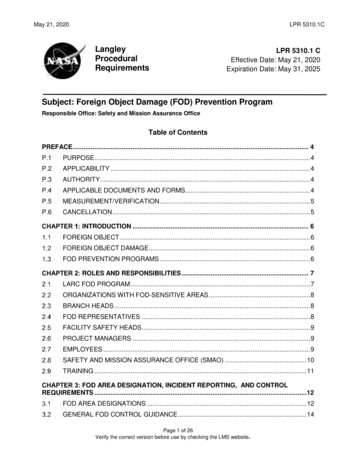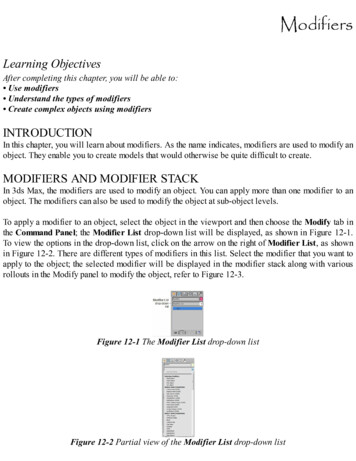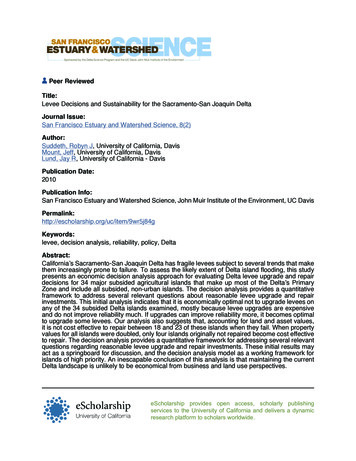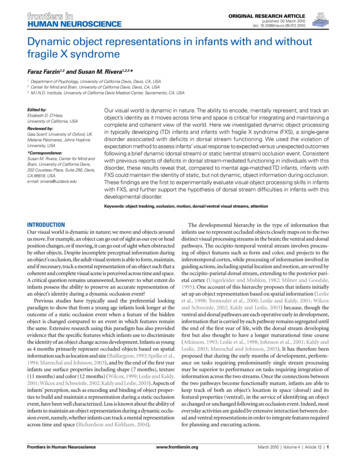
Transcription
ORIGINAL RESEARCH ARTICLEpublished: 02 March 2010doi: 10.3389/neuro.09.012.2010HUMAN NEUROSCIENCEDynamic object representations in infants with and withoutfragile X syndromeFaraz Farzin1,2 and Susan M. Rivera1,2,3*123Department of Psychology, University of California Davis, Davis, CA, USACenter for Mind and Brain, University of California Davis, Davis, CA, USAM.I.N.D. Institute, University of California Davis Medical Center, Sacramento, CA, USAEdited by:Elizabeth D. O’Hare,University of California, USAReviewed by:Gaia Scerif, University of Oxford, UKMelanie Palomares, Johns HopkinsUniversity, USA*Correspondence:Susan M. Rivera, Center for Mind andBrain, University of California Davis,202 Cousteau Place, Suite 250, Davis,CA 95618, USA.e-mail: srivera@ucdavis.eduOur visual world is dynamic in nature. The ability to encode, mentally represent, and track anobject’s identity as it moves across time and space is critical for integrating and maintaining acomplete and coherent view of the world. Here we investigated dynamic object processingin typically developing (TD) infants and infants with fragile X syndrome (FXS), a single-genedisorder associated with deficits in dorsal stream functioning. We used the violation ofexpectation method to assess infants’ visual response to expected versus unexpected outcomesfollowing a brief dynamic (dorsal stream) or static (ventral stream) occlusion event. Consistentwith previous reports of deficits in dorsal stream-mediated functioning in individuals with thisdisorder, these results reveal that, compared to mental age-matched TD infants, infants withFXS could maintain the identity of static, but not dynamic, object information during occlusion.These findings are the first to experimentally evaluate visual object processing skills in infantswith FXS, and further support the hypothesis of dorsal stream difficulties in infants with thisdevelopmental disorder.Keywords: object tracking, occlusion, motion, dorsal/ventral visual streams, attentionINTRODUCTIONOur visual world is dynamic in nature; we move and objects aroundus move. For example, an object can go out of sight as our eye or headposition changes, or if moving, it can go out of sight when obstructedby other objects. Despite incomplete perceptual information duringan object’s occlusion, the adult visual system is able to form, maintain,and if necessary, track a mental representation of an object such that acoherent and complete visual scene is perceived across time and space.A critical question remains unanswered, however: to what extent doinfants possess the ability to preserve an accurate representation ofan object’s identity during a dynamic occlusion event?Previous studies have typically used the preferential lookingparadigm to show that from a young age infants look longer at theoutcome of a static occlusion event when a feature of the hiddenobject is changed compared to an event in which features remainthe same. Extensive research using this paradigm has also providedevidence that the specific features which infants use to discriminatethe identity of an object change across development. Infants as youngas 4 months primarily represent occluded objects based on spatialinformation such as location and size (Baillargeon, 1993; Spelke et al.,1994; Mareschal and Johnson, 2003), and by the end of the first yearinfants use surface properties including shape (7 months), texture(11 months) and color (12 months) (Wilcox, 1999; Leslie and Kaldy,2001; Wilcox and Schweinle, 2002; Kaldy and Leslie, 2003). Aspects ofinfants’ perception, such as encoding and binding of object properties to build and maintain a representation during a static occlusionevent, have been well characterized. Less is known about the ability ofinfants to maintain an object representation during a dynamic occlusion event, namely, whether infants can track a mental representationacross time and space (Richardson and Kirkham, 2004).Frontiers in Human NeuroscienceThe developmental hierarchy in the type of information thatinfants use to represent occluded objects closely maps on to the twodistinct visual processing streams in the brain; the ventral and dorsalpathways. The occipito-temporal ventral stream involves processing of object features such as form and color, and projects to theinferotemporal cortex, while processing of information involved inguiding actions, including spatial location and motion, are served bythe occipito-parietal dorsal stream, extending to the posterior parietal cortex (Ungerleider and Mishkin, 1982; Milner and Goodale,1995). One account of this hierarchy proposes that infants initiallyset up an object representation based on spatial information (Leslieet al., 1998; Tremoulet et al., 2000; Leslie and Kaldy, 2001; Wilcoxand Schweinle, 2002; Kaldy and Leslie, 2003) because, though theventral and dorsal pathways are each operative early in development,information that is carried by each pathway remains segregated untilthe end of the first year of life, with the dorsal stream developingfirst but also thought to have a longer maturational time course(Atkinson, 1993; Leslie et al., 1998; Johnson et al., 2001; Kaldy andLeslie, 2003; Mareschal and Johnson, 2003). It has therefore beenproposed that during the early months of development, performance on tasks requiring predominantly single stream processingmay be superior to performance on tasks requiring integration ofinformation across the two streams. Once the connections betweenthe two pathways become functionally mature, infants are able tokeep track of both an object’s location in space (dorsal) and itsfeatural properties (ventral), in the service of identifying an objectas changed or unchanged following an occlusion event. Indeed, mosteveryday activities are guided by extensive interaction between dorsal and ventral representations in order to integrate features requiredfor planning and executing actions.www.frontiersin.orgMarch 2010 Volume 4 Article 12 1
Farzin and RiveraObject representations in infantsThe functional, anatomical, and developmental dissociationbetween ventral and dorsal pathways has been influential forresearchers investigating visual processing in various developmental disorders. Because of its protracted developmental timecourse, it has been suggested that the dorsal stream is particularlyvulnerable to atypical development (Atkinson, 2000), thereby leading to a preponderance of dorsal stream deficits in developmentaldisorders, including fragile X syndrome (FXS).FXS is the most is the most prevalent form of inherited mentalretardation, with 1 in 3,800 males estimated to have the FXS fullmutation and as many as 1 in 2,300 women estimated to carry thefull mutation on at least one X chromosome (Crawford et al., 2001;Beckett et al., 2005). FXS is also the most common single-genecause of autism (Reddy, 2005). The neurodevelopmental disorderis caused by the silencing of a single gene on the X chromosome,the Fragile X Mental Retardation 1 gene (Verkerk et al., 1991),which results in the reduction or absence of the fragile X mentalretardation protein (FMRP) coded for by the gene. FMRP playsa key role in the post-synaptic development of dendritic spinemorphology and acts as a repressor by regulating the translationof multiple dendritic mRNAs involved in synaptic developmentand function (Brown et al., 1982; Irwin et al., 2002). Dendriticabnormalities have been found in occipito-parietal areas of FMR1knock-out mice as well as visual cortices of autopsied tissue frompatients with FXS (Comery et al., 1997; Irwin et al., 2002), suggesting that FMRP is an important protein in the developmentof neural networks involving visual areas of the brain. Becauseof its specific single gene etiology, FXS offers a unique opportunity to examine the functional role of a specific gene product onneurocognitive development, and more specifically on functionssupported by the dorsal stream.There is ample evidence showing that visual processing deficits observed in individuals with FXS are not global in nature;rather, deficits in this population are specific to tasks mediatedby the dorsal stream. A finding that emerges consistently acrossneuropsychological studies in children and adults with FXS isthat affected individuals perform worse than typically developing(TD) controls on tasks requiring visual-spatial and visual-motorcoordination, such as replication of an abstract block design orcopying a drawing from a model, while visual recognition andmatching abilities are relatively unimpaired. Studies using visualpsychophysics have reported that adolescents and adults with FXSshow reduced contrast sensitivity for low spatial and high temporalfrequency visual stimuli known to engage magnocellular pathwayprocessing, but intact sensitivity for high spatial and low temporal frequency stimuli that elicit parvocellular pathway processing (Kogan et al., 2004a). Furthermore, impaired sensitivity fordiscriminating second-order static and first- and second-ordermoving visual stimuli, accompanied by near normal sensitivityfor first-order static stimuli, has been found in adolescents andadults with FXS (Kogan et al., 2004b). These studies have beenseminal in refining the picture of visual deficits in individuals withFXS, suggesting typical ventral stream processing accompanied byeither atypical dorsal stream processing or a generalized impairment in higher-level neural mechanisms necessary for integratingdorsal and ventral visual input. These interpretations need not beFrontiers in Human Neurosciencemutually exclusive. Recent work investigating visual processing ininfants with FXS has revealed that a selective deficit in sensitivityfor detecting second-order motion stimuli can be identified earlyin development (Farzin et al., 2008). Because attentive trackingis believed to be necessary for the detection of dynamic secondorder stimuli (Sperling, 1989; Cavanagh, 1992; Johnston et al.,1992; Nishida and Sato, 1995; Seiffert and Cavanagh, 1998), thisfinding was explained as a deficit in temporal or motion processing in infants with FXS, as either could result in poor attentivetracking and both types of processing are subserved by parietalareas of the brain. These results are consistent with and extendthe work of Kogan et al. (2004b) by uncovering the developmentaltrajectory of the putative dorsal stream deficit in both male andfemale infants diagnosed with FXS. However, given that infantswith FXS performed comparable to TD controls when detecting first-order motion stimuli, which are processed by a passive,velocity sensitive mechanism (Seiffert and Cavanagh, 1998), theseresults also call into question whether a low-level motion processing or strictly subcortical deficit exists in individuals with FXS.While we cannot directly compare levels of sensitivity obtainedfrom infants in our study to sensitivity found in adults becauseof differences in stimuli (second-order stimuli are defined differently), tasks (detection versus discrimination), and age groups,we can speculate that FMRP may have a protracted time coursein the early development of visual areas.Other evidence of developmental visual abnormalities comesfrom studies with toddlers with FXS. First, Scerif et al. (2004)investigated selective visual attention in 2- and 3-year-olds withFXS using a visual search task, and found that the FXS groupshowed a perseverative error of selecting targets that had previously been found. Another study examined oculomotor controlin toddlers with FXS (Scerif- et al., 2005) by presenting childrenwith a task in which the goal was to inhibit saccades toward suddenly appearing peripheral stimuli (prosaccades) and direct theminstead to contralateral locations (antisaccades). Consistent withthe above finding of deficits in selective visual attention, theyfound that toddlers with FXS failed to suppress prosaccadestoward the cue during the test trials, likely caused by atypicalconnectivity between parietal and frontal circuitry (McDowellet al., 2008). Taken together, these findings begin to converge ona picture of visual processing in young individuals with FXS inwhich there exists a disruption in the ‘vision-for-action’ pathway,or the dorsal stream (Milner and Goodale, 1995).Here we conducted two experiments to assess how infants withand without FXS process changes in object properties duringocclusion events which either involve a dynamic transformationacross time and space, engaging dorsal stream processing, or whichremain static, engaging ventral stream processing. The tasks weredesigned based on the hypothesis that dysfunction of parietal areasin processing basic spatial and temporal visual information is likelyto be the underpinning source of cognitive impairments found inindividuals with FXS. These findings presented here provide us witha better understanding of the development of dynamic object representations in typically and atypically developing infants, bridgingthe link between specific gene expression, brain development, andcognitive function.www.frontiersin.orgMarch 2010 Volume 4 Article 12 2
Farzin and RiveraObject representations in infantsEXPERIMENT 1Apparatus and stimuliMATERIALS AND METHODSStimuli were presented on a Tobii 17-inch LCD binocular eye tracker(1024 768 pixels resolution, 50-Hz capture rate, 60-Hz refreshrate) to record infants’ fixations during the task. The calibrationprocedure was run using ClearView software (Tobii Technology,Sweden), which allows an optimal accuracy of 0.5 .Stimulus creation and programming were done using AdobeFlash CS4 Professional software. Infants were shown two objects;a red sphere and a green cylinder, each fitting within a 5 deg by5 deg square, presented 4 deg from the midline, against a blackbackground. Each occluder was a white square that fully coveredthe object. During the task infants heard audio sequences of classical music through two standard computer speakers concealedbehind the monitor.ParticipantsThirty-two infants diagnosed with the FXS full mutation (27 boysand 5 girls) and thirty-four mental age-matched full-term TDinfants (27 boys and 7 girls) were included in the final sample. Meanchronological age for the FXS and TD groups was 26.37 months( 7.15, range 14–45 months) and 18.09 months ( 5.51,range 11–31 months), respectively. Data from an additional threeTD infants and four infants with FXS were not included in the finalanalysis because the infant did not provide gaze data on all four testtrials. TD infants were recruited through letters to families, fliers,and word of mouth in Davis, California. Infants with FXS wererecruited from, and clinically evaluated at, the UC Davis M.I.N.D.Institute Fragile X Research and Treatment Center (FXRTC), andmolecular DNA testing was carried out to confirm their diagnosis.The Institutional Review Board at the University of California,Davis, approved the experimental protocol, and informed consentwas obtained from a parent or caregiver of each infant.Cognitive assessment. To control for differences in developmentallevel, all infants with FXS were assessed using the Mullen Scalesof Early Learning (Mullen, 1995) to derive a mental age. TheMSEL is a standardized developmental test for children ages 3 to60 months, consisting of five subscales: gross motor, fine motor,visual reception, expressive language, and receptive language.Infants in the FXS group had a mean mental age of 17.39 months( 5.76, range 11–36 months), which was matched to infants inthe TD group (18.35 months 5.35, range 11–31 months). Anindependent samples t-test confirmed that mental age did notdiffer significantly between the two final groups (t(1, 64) 0.702,p 0.485, 2-tailed).ProcedureInfants were seated on a parent or caregiver’s lab, 60 cm from the eyetracker monitor. The experiment began with a five-point calibrationroutine, followed by a single familiarization trial and four test trials.Figure 1 presents a schematic of the experimental design.Familiarization trial. A red sphere on the left and a green cylinderon the right were lowered from the top to the middle of the screenat a speed of 3 cm/s. The objects remained stationary for 5 s, afterwhich they were concealed for 1 s by the occluders, also loweredfrom the top of the screen. The occluders were then raised to revealthe objects for 1 s and were lowered immediately after to re-occludethe shapes for 1 s. The occluders revealed the objects a final time andthen dropped back down. The purpose of this trial was to provideinfants with sufficient time to visually examine each object and itslocation, and to learn that the role of the occluders was to hide theobjects without transforming them in any way.FIGURE 1 Schematic of Experiment 1 design. Note that on the computer screen the background was black, the occluders were white, and the arrows werenot present.Frontiers in Human Neurosciencewww.frontiersin.orgMarch 2010 Volume 4 Article 12 3
Farzin and RiveraObject representations in infantsCodingEye tracking data was coded using the Area-of-Interest definitiontool within ClearView. AOIs were defined by creating a 6 deg by 6deg square around each object. The primary measure of interestincluded duration of fixations to each AOI region, where a fixationwas defined as a period of looking in which the position of theeyes did not shift more than 30 pixels for a minimum of 200 ms.Fixations outside of the two AOIs were coded as either “away” oroff-screen. Coding began once the occluders were raised to revealhalf of the objects and ended when the objects were fully re-concealed. Mean looking time during each test trial was then calculatedby summing the fixation duration to the two AOIs.RESULTS AND DISCUSSIONPreliminary analyses of mean looking time differences betweenthe expected and unexpected outcomes using a repeated measuresanalysis of variance (ANOVA) showed no effects involving mentalage, gender, or trial order; therefore these factors were excludedfrom the following analyses. Mean looking time during each testtrial was entered into a repeated measures ANOVA with two withinsubject factors: outcome (expected or unexpected) and trial pair(first or second), and one between-group factor: group (typicallydeveloping or FXS). The analysis revealed a significant main effectof diagnosis (F(1, 64) 14.03, p 0.0001, η2 0.180) whereby TDinfants looked significantly longer overall (M 6.31 s, SD 2.38 s)compared to infants with FXS (M 4.29 s, SD 2.57 s). Asignificant interaction between outcome and diagnosis (F(1,64) 7.502, p 0.008, η2 0.105) was also found, driven by TDinfants’ longer looking times during the unexpected (M 6.86 s,SD 2.11 s) than the expected (M 5.76 s, SD 2.55 s) outcometest trials (t(32) 2.556, p 0.015, SEM 0.43). Infants with FXStrended toward longer looking during the expected (M 4.52 s,SD 2.67 s) than the unexpected (M 4.05 s, SD 2.47 s) outcome test trials (t(31) 1.507, p 0.142, SEM 0.35). A binomial sign confirmed that while 24 out of 34 (71%, p 0.024) TDFrontiers in Human Neuroscienceinfants looked longer at the unexpected compared to expectedoutcome trials, only 16 out of 32 (50%, p 1.14) infants with FXSlooked longer at unexpected outcome trials. No other significanteffects or interactions were found. Figure 2 shows mean lookingtimes during the expected and unexpected test trial outcomes forthe two groups.Perhaps infants with FXS neglected to track the movement of theoccluders during the rotation period, thereby leaving them unableto respond to the unexpected object location. To answer this question, a third AOI was created which encompassed the area throughwhich the occluders moved, and looking time was calculated foreach infant and each test trial. The result of an independent samplest-test confirmed that mean looking time to the occluders duringthe rotation periods did not differ significantly between the twogroups (t(1, 64) 2.255, p 0.136, 2-tailed), thus the failure ofinfants with FXS to look longer at the unexpected outcome cannot be attributed to differences in looking time to the rotation ofthe occluders. There was also no difference in looking time duringthe familiarization period between infants with and without FXS(t(1, 64) 2.920, p 0.092, 2-tailed), which could have influencedperceptual novelty preferences.These results demonstrate that TD infants successfully maintained the identity of an occluded object across a spatiotemporaltransformation, and infants with FXS did not. Instead, infantswith FXS showed a tendency to look longer during the expectedtest trial outcome, suggesting that the object representation wasnot maintained throughout the rotation of the occluders. Thus,objects in their new positions may have violated the expectationthat object features would remain bound to their original locations. This looking pattern was not dependent on age, sex, test trialorder, looking time during the familiarization trial, or time spentlooking at the occluders during the transformation period.Attentive tracking of occluded objects is believed to involve correspondence matching of features across changing spatial positions over time, a function shown to be mediated by parietal andfrontal areas of the brain (Cavanagh, 1992; Yantis, 1992; Culhamet al., 1998, 2001). Therefore, these results support the hypothesisthat infants with FXS are impaired on an object occlusion taskLooking Time (s)Test trials. Two pairs of test trials were presented in one of twoorders: expected, unexpected, unexpected, expected or unexpected,expected, expected, unexpected, counterbalanced across subjects.The test trials were similar to the familiarization trial in thatfollowing a 5-s viewing period of the objects, the occluders werelowered to cover the objects. During a 5-s occlusion, the occluders rotated 180 in a clockwise direction (local orientation maintained), after which they were raised to reveal either the objects intheir newly rotated positions whereby the cylinder was now on theleft (expected outcome) or the objects in their original positions(unexpected outcome). Infants were given 10 s to view the outcome,after which the occluders were lowered and rotated counterclockwise back to their starting positions, and the screen faded to black.After 2 s the subsequent test trial began and the sequence repeateduntil all four test trials were completed. The total task lasted 2 minand 24 s. It was predicted that if infants successfully encoded andbound the individual object identities to specific spatial locations,and tracked this information during the dynamic occlusion period,they should respond to the violation of object location by looking longer at the unexpected outcome compared to the expectedoutcome.876543210*expected outcomeunexpected outcomeTDFXSFIGURE 2 Results from Experiment 1. Mean looking time in seconds to theexpected (white bars) and unexpected (gray bars) test trial outcomes for eachgroup. The effect of outcome was significant only in TD infants, as indicated byan asterisk (p 0.05). Error bars represent SEM.www.frontiersin.orgMarch 2010 Volume 4 Article 12 4
Farzin and RiveraObject representations in infantsrequiring dorsal stream function, either as a result of a selectivespatial or temporal processing deficit or a deficit in the processingof integrated spatiotemporal information.EXPERIMENT 2To rule out the possibility that infants with FXS were unableto maintain an object representation during a period of staticocclusion, a control experiment was performed using the sameexperimental procedure but removing the dynamic quality of theocclusion. Namely, in this experiment, there was no spatiotemporaltransformation during the occlusion period; rather, the occluders remained static and the object property that changed duringthe occlusion period was color. Color was selected as the featureviolation because it is known to differentially activate the ventralpathway. The question was whether infants with FXS would be ableto form accurate expectations about the identity of the occludedobjects in the absence of the occluders’ motion.( 5.15, range 11–32 months), respectively. Infants in theFXS group had a mean mental age of 16.54 months ( 5.74,range 11–28 months), matched to infants in the TD group(16.88 months 4.96, range 11–32 months). There was no significant difference between the two groups on developmental level(t(1, 55) 0.244, p 0.809, 2-tailed).Twelve TD infants were not included as a result of poor calibration (1), parent verbal interference (1), or incomplete gaze datafor all four test trials (10). Data from an additional eight infantswith FXS were not included in the final analysis because of poorcalibration (2) or incomplete gaze data (6).Apparatus and stimuliInfants were shown two objects; an orange triangle and a blue circle,each fitting within a 5 deg by 5 deg square region, presented 4 degfrom the midline, against a black background. Each occluder wasa white square that fully covered the object.MATERIALS AND METHODSProcedureThe method was the same as in Experiment 1 unless otherwisenoted.Figure 3 presents a schematic of the experimental design.ParticipantsTwenty-four infants diagnosed with the FXS full mutation (19boys and 4 girls) and thirty-three mental age-matched full-termTD infants (25 boys and 8 girls) were included in the final sample. Mean chronological age for the FXS and TD groups was27.52 months ( 8.36, range 11–46 months) and 16.52 monthsFamiliarization trial. Infants were presented with a blue triangleon the left and an orange circle on the right, lowered from the top tothe middle of the screen at a speed of 3 cm/s. The objects remainedstationary for 5 s, after which the occluders were lowered to concealthe objects for 1 s. The occluders were then raised to reveal theobjects for 1 s and were immediately lowered to re-occlude theshapes for 1 s. This process was repeated a second time.FIGURE 3 Schematic of Experiment 2 design. Note that on the computer screen the background was black, the occluders were white, and the arrows werenot present.Frontiers in Human Neurosciencewww.frontiersin.orgMarch 2010 Volume 4 Article 12 5
Farzin and RiveraObject representations in infantsCodingCoding was the same as in Experiment 1. In addition to meanlooking time during each test trial, a Visual Preference (VP) score,indexing the proportion of looking time to the object that changedcolor, was calculated using the following formula: (looking time tochanged object)/(looking time to both objects). VP scores couldbe between 0 and 1, with 0.5 considered equal preference for bothobjects. For each infant, a VP score was calculated for each unexpected outcome test trial1.SD 3.24 s), most likely an effect of boredom or fatigue towardthe end of the task. No other significant effects or interactions werefound. Critically, there was not a significant interaction betweenoutcome and group (F(1, 55) 0.572, p 0.453). Figure 4 showsmean looking times to the expected and unexpected test trial outcomes for the two groups.These findings were further explored by conducting a seriesof planned comparisons (paired t-tests) showing that TD infantslooked significantly longer to the unexpected (M 6.44 s,SD 3.15 s) than the expected (M 5.55 s, SD 3.04 s) outcome test trial for the first pair of test trials (t(32) 2.441,p 0.019, SEM 0.59) and significantly longer to the unexpected (M 5.69 s, SD 3.28 s) than the expected (M 4.06 s,SD 2.56 s) outcome test trial for the second pair of test trials (t(32) 3.216, p 0.003, SEM 0.50). Infants with FXSlooked significantly longer to the unexpected (M 4.65 s,SD 3.11 s) than the expected (M 3.54 s, SD 3.55 s) outcome test trial for the first pair of test trials (t(23) 2.514,p 0.020, SEM 0.43) and trended toward longer looking tothe unexpected (M 3.88 s, SD 3.47 s) compared to expectedoutcome (M 3.28 s, SD 3.39 s) test trial for the second pairALooking Time (s)Test trials. Two pairs of test trials were presented in one of twoorders: expected, unexpected, unexpected, expected or unexpected, expected, expected, unexpected, counterbalanced acrossinfants.The test trials were similar to the familiarization trial in thatthe objects were presented and remained stationary for 5 s. Theoccluders were lowered to cover the objects for a period of 5 s,during which they remained stationary.The occluders were then raised to reveal either the unchangedobjects (expected outcome) or one object that had changed color(unexpected outcome). To avoid presenting infants with a novelcolor, the object was changed to match the color of the secondobject (orange to blue or blue to orange; color of changed objectalternated on unexpected trials). Infants were given 10 s to viewthe trial outcome, after which the occluders were lowered and thescreen faded to black. After 2 s, the subsequent test trial began.The total task lasted 2 min and 24 s. We expected that if infantsencoded and bound the features of each object to their appropriate spatial location, and retained this information during thestatic occlusion, they should respond to the violation of color bydemonstrating increased looking time to the unexpected outcomecompared to the expected outcome trials. More specifically, infantsshould look longer at the spatial location of the object whoseidentity changed.876543210RESULTS AND DISCUSSION1Note that a VP score calculation was not possible for Experiment 1 because theunexpected outcome consisted of both objects in their original positions and therewas therefore no reason to believe that infants would choose to look at the locationof one object longer than the other.Frontiers in Human Neuroscienceexpected outcomeunexpected outcome*TDFXS**TDFXSB0.7Visual PreferencePreliminary analyses of mean looking time differences betweenthe expected and unexpected
1 Department of Psychology, University of California Davis, Davis, CA, USA 2 Center for Mind and Brain, University of California Davis, Davis, CA, USA 3 M.I.N.D. Institute, University of California Davis Medical Center, Sacramento, CA, USA Our visual world is dynamic in nature. The ability to encode, mentally represent, and track an

